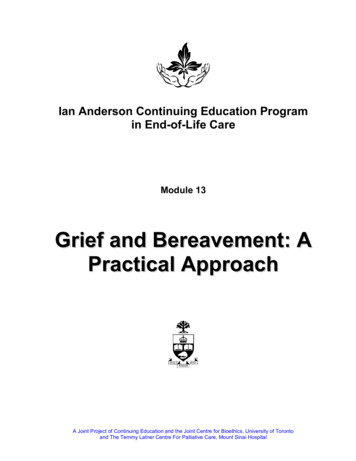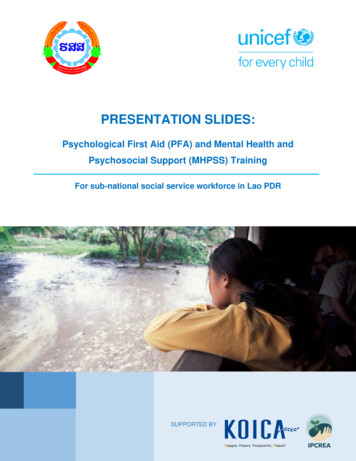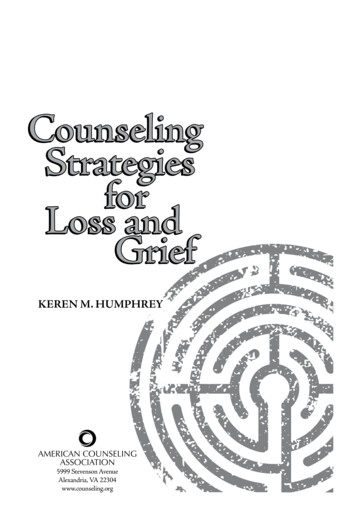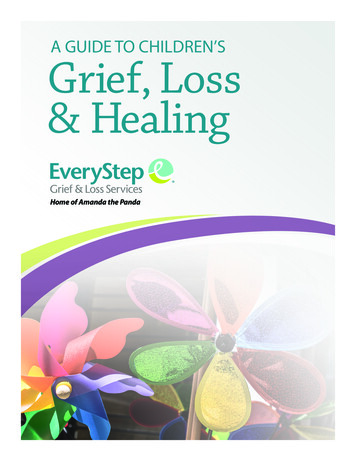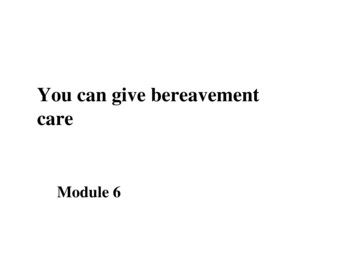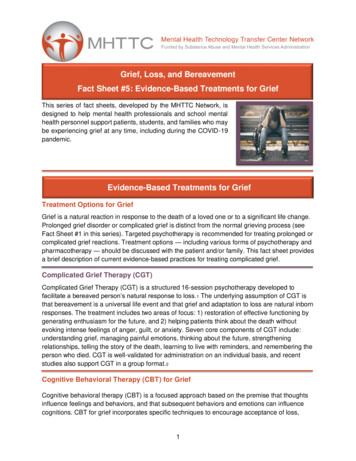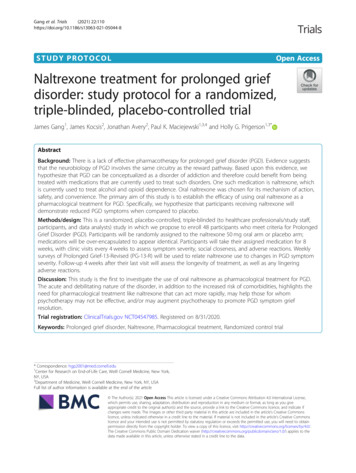
Transcription
Gang et al. Trials(2021) UDY PROTOCOLOpen AccessNaltrexone treatment for prolonged griefdisorder: study protocol for a randomized,triple-blinded, placebo-controlled trialJames Gang1, James Kocsis2, Jonathan Avery2, Paul K. Maciejewski1,3,4 and Holly G. Prigerson1,3*AbstractBackground: There is a lack of effective pharmacotherapy for prolonged grief disorder (PGD). Evidence suggeststhat the neurobiology of PGD involves the same circuitry as the reward pathway. Based upon this evidence, wehypothesize that PGD can be conceptualized as a disorder of addiction and therefore could benefit from beingtreated with medications that are currently used to treat such disorders. One such medication is naltrexone, whichis currently used to treat alcohol and opioid dependence. Oral naltrexone was chosen for its mechanism of action,safety, and convenience. The primary aim of this study is to establish the efficacy of using oral naltrexone as apharmacological treatment for PGD. Specifically, we hypothesize that participants receiving naltrexone willdemonstrate reduced PGD symptoms when compared to placebo.Methods/design: This is a randomized, placebo-controlled, triple-blinded (to healthcare professionals/study staff,participants, and data analysts) study in which we propose to enroll 48 participants who meet criteria for ProlongedGrief Disorder (PGD). Participants will be randomly assigned to the naltrexone 50 mg oral arm or placebo arm;medications will be over-encapsulated to appear identical. Participants will take their assigned medication for 8weeks, with clinic visits every 4 weeks to assess symptom severity, social closeness, and adverse reactions. Weeklysurveys of Prolonged Grief-13-Revised (PG-13-R) will be used to relate naltrexone use to changes in PGD symptomseverity. Follow-up 4 weeks after their last visit will assess the longevity of treatment, as well as any lingeringadverse reactions.Discussion: This study is the first to investigate the use of oral naltrexone as pharmacological treatment for PGD.The acute and debilitating nature of the disorder, in addition to the increased risk of comorbidities, highlights theneed for pharmacological treatment like naltrexone that can act more rapidly, may help those for whompsychotherapy may not be effective, and/or may augment psychotherapy to promote PGD symptom griefresolution.Trial registration: ClinicalTrials.gov NCT04547985. Registered on 8/31/2020.Keywords: Prolonged grief disorder, Naltrexone, Pharmacological treatment, Randomized control trial* Correspondence: hgp2001@med.cornell.edu1Center for Research on End-of-Life Care, Weill Cornell Medicine, New York,NY, USA3Department of Medicine, Weill Cornell Medicine, New York, NY, USAFull list of author information is available at the end of the article The Author(s). 2021 Open Access This article is licensed under a Creative Commons Attribution 4.0 International License,which permits use, sharing, adaptation, distribution and reproduction in any medium or format, as long as you giveappropriate credit to the original author(s) and the source, provide a link to the Creative Commons licence, and indicate ifchanges were made. The images or other third party material in this article are included in the article's Creative Commonslicence, unless indicated otherwise in a credit line to the material. If material is not included in the article's Creative Commonslicence and your intended use is not permitted by statutory regulation or exceeds the permitted use, you will need to obtainpermission directly from the copyright holder. To view a copy of this licence, visit http://creativecommons.org/licenses/by/4.0/.The Creative Commons Public Domain Dedication waiver ) applies to thedata made available in this article, unless otherwise stated in a credit line to the data.
Gang et al. Trials(2021) 22:110Administrative informationThe order of the items has been modified to group similar items (see items-for-clinical-trials/).Title {1}Naltrexone treatment for prolongedgrief disorder: study protocol for arandomized, triple-blinded, placebocontrolled trialTrial registration {2a and 2b}ClinicalTrials.gov, NCT04547985.Registered on 8/31/2020, otocol version {3}10/08/20; v2.2Funding {4}This work is supported by the NationalCancer Institute (NCI) (grant numberCA197730 and CA218313) and theClinical Translational Science Center(CTSC), National Center for AdvancingTranslational Sciences (NCATS) grantTR002384.Author details {5a}JG, PM, HGP are affiliated with theCenter for Research on End-of-Life Careat Weill Cornell Medicine. PA and JK areaffiliated with the Department of Psychiatry at Weill Cornell medicine.Name and contactinformation for the trialsponsor {5b}Weill Medical College of CornellUniversity1300 York Avenue, Box 305New York, NY 10065Phone: (646) 962-8215Role of sponsor {5c}Funders played no role in the design ofthis study and will not have any roleduring its execution, analyses,interpretation of the data, or decisionto submit results.IntroductionBackground and rationale {6a}The recent inclusion of prolonged grief disorder (PGD)in the ICD-11 [1, 2] and the DSM [3, 4] has been a catalyst for research to advance understanding and treatment of this newly recognized mental disorder. PGD, amaladaptive response to the death of a loved one, ischaracterized by persistent yearning for the deceasedand disabling symptoms such as emotional numbness, asense of disbelief about the death, identity disruption,and an inability to move on and find meaning in life inthe absence of the deceased [5]. When these symptomsare functionally impairing and severe at 12 months postloss, a person can now be diagnosed as meeting criteriafor PGD [5]. The 7–10% of bereaving people estimatedto be meet criteria for PGD have been shown to be at increased risk of medical conditions and diseases (e.g.,hypertension, immunological dysfunction, cancer), physical and mental impairments, reduced quality of life, suicidal ideation (SI) and attempts, emergency room visits,Page 2 of 15and multiple nights spent in the hospital [6–9]. The severe and substantial risks posed by a PGD diagnosishighlight the need to investigate ways to help those suffering from this new mental disorder.While psychotherapy tailored specifically for PGD hasproven effective in reducing PGD symptom severity insome people [10, 11], the acute and debilitating natureof the disorder highlights the need for pharmacologicaltreatment that can act more rapidly, may help those forwhom psychotherapy may not be effective, and/or mayaugment psychotherapy to promote PGD symptomgrief resolution. Current evidence on pharmacologicalintervention for PGD is scarce. One barrier to testingpharmacologic agents has been the absence of PGD asa recognized mental disorder. Based on the clinicalrationale that PGD exhibits similar symptoms to majordepressive disorder (MDD) and post-traumatic stressdisorder (PTSD), selective serotonin reuptake inhibitors(SSRIs) have been explored in three open-label trialsand one case series. While these studies demonstratemoderate effectiveness in reducing grief symptoms, theresults are confounded by high rates of comorbid mental disorders, and the scientific rigor has been undermined by lack of randomization and blinding, smallsample sizes, and low levels of statistical power [12].The other medications trialed have included tricyclicantidepressants (TCAs) and benzodiazepines, both ofwhich have not proven effective for the reduction ofsymptoms of PGD [13, 14].We believe that treating PGD as a disorder akin toMDD or PTSD is misguided, for two main reasons. Thefirst reason is that PGD has been shown to demonstratea distinct neural profile when compared to MDD orPTSD [15]. In contrast to conceptualizing PGD as amood disorder such as MDD or a stress responsesyndrome such as PTSD, there is emerging evidence tosuggest that PGD may be conceptualized as a rewarddysfunction disorder, with the deceased person as therewarding stimulus for whom the bereaved personyearns [16]. PGD, as noted above, is at its core adisorder of attachment and a craving and yearning forthe deceased from whom they are separated (resulting insignificant separation distress). In PGD, the primarygateway symptom required for diagnosis is yearning:persistent longing, pining for, or preoccupation with, thedeceased. In this way, patients with PGD continue to“crave” their loved ones after they have died, due to thepositive reinforcement provided by their memories ofloved ones. The absence of the deceased creates a feelingof withdrawal—missing the person, feeling focused onhis or her absence, feeling like life is not pleasurable andactually painful without the deceased, sorrow, resentmentand agitation at being denied the support and security,meaning, and identity the deceased provided.
Gang et al. Trials(2021) 22:110A second reason for finding an alternative to SSRIs forthe treatment of PGD is that they take weeks to monthsto achieve full efficacy. Persons suffering from PGD wouldbenefit from faster acting interventions, especially givensignificant suicide attempt risk of those meeting criteriafor PGD [17]. A delay in resolution of PGD symptomswould protract the period of risk for suicidal thoughts andbehaviors with which PGD is associated [4, 17].Neurobiologically, numerous studies suggest that thereare associations between symptoms of PGD and thereward pathway, which is the same pathway primarilyresponsible for addiction [16]. The reward pathwayrefers to a group of interconnected structures in thebrain that uses dopamine as a signal to modulate theexperience of reward. Some pertinent examples ofenhanced activation in brain structures in PGD that arealso important to the reward pathway include thenucleus accumbens [18] and orbitofrontal cortex [15].Based on evidence supporting an association betweenPGD and neurobiological correlates of reward andaddiction, we hypothesize that treatments for addictionmight prove successful where those of MDD and PTSDhave failed. Currently, disorders of addiction are treatedwith a wide variety of medications based upon thesubstance being abused, including bupropion andvarenicline for tobacco use; naltrexone and acamprosatefor alcohol use; methadone and buprenorphine for opioiduse [19]. Of these, we have opted to trial naltrexone totreat PGD because of its mechanism of action, effects onsocial attachment, and side-effect profile.Mechanistically, naltrexone is a competitive antagonistof opioid receptors. These receptors, when bound byendogenous opioids released in response to rewardingstimuli, normally cause the subsequent release ofdopamine in the reward pathway. Therefore, naltrexonemay be an appropriate choice to treat PGD, as itsmechanism of action directly affects the reward pathway;by blocking opioid receptors, release of dopamine in thereward pathway is inhibited. It also has two practicaladvantages for patients. First, it can be administeredorally (daily) or intramuscularly (monthly). Second, costof oral naltrexone is not prohibitively high and is oftencovered by insurance [20].Symptomatically, naltrexone targets two crucial aspectsof PGD. First, assuming that having and maintainingsocial connections is vital to human functioning, theopioid theory of social attachment suggests thatendogenous opioids are released during these experiencesof social bonding, which then underlie the pleasantfeelings of social bonding to positively reinforce theformation of such bonds. Based on this theory, studieshave shown that naltrexone reduces feelings of socialconnection, especially to one’s closest others [21, 22].Reduced positive associations with significant others,Page 3 of 15especially the deceased, may make bereavement feel lesslonely and isolated while diminishing the reward derivedfrom reminiscing about the deceased. Second, metaanalysis confirms that naltrexone reduces craving in patients with alcohol dependence [23]; in PGD, craving thedeceased is the core symptom [5]. Thus, naltrexone mayreduce the craving for the deceased and thereby severityof PGD. Given these findings, we predict that naltrexonewill provide a pharmacological way to dampen the benefits of social bonding while reducing the yearning or craving for the deceased loved one, which would reduce theseverity of PGD.With respect to side effects, naltrexone is welltolerated and may be better tolerated than TCAs orSSRIs. The most common side effects of naltrexone include nausea, vomiting, abdominal pain, headache, andfatigue. The most severe side effect warranting an FDAblack-box warning is hepatotoxicity; in the COMBINEstudy, elevations in liver function tests (LFTs) were seenin only 11 of 614 participants, with most normalizingafter cessation and no serious long-term consequences[24]. In addition, although naltrexone can cause suddenand severe withdrawal in opiate users, we would not trialnaltrexone in bereaved individuals who are opiate users.Objectives {7}The primary objective is to determine the efficacy ofnaltrexone in reducing PGD symptoms compared toplacebo.Secondary objectiveThe secondary objective is to evaluate the effects ofnaltrexone on social closeness with both the deceased(the bereaved person) and the living (surviving othersand social network).Exploratory objectives To evaluate associations between naltrexone andsocial integration and social connectedness. To evaluate associations between naltrexone andsuicidal thoughts and behaviors. To evaluate associations between naltrexone andhealth behaviors (e.g., alcohol and tobacco use,sleep, food consumption). To evaluate associations between outcomes ofCOVID-19-related deaths versus other causes ofdeath.Trial design {8}This study is designed as a randomized, placebocontrolled, triple-blinded (to healthcare professionals,participants, and data analysts), stage IV, single-site superiority trial with two parallel groups.
Gang et al. Trials(2021) 22:110Methods: participants, interventions andoutcomesStudy setting {9}The study will take place at NewYork Presbyterian –Weill Cornell Medicine (NYP-WCM) in New York, NY,USA.Eligibility criteria {10}Inclusion criteria1. 18 years of age or older and younger than 90 yearsof age.2. Lives within a reasonable distance from NYP-WCMfor convenient clinic visits.3. Can speak, read, and write English proficiently.4. Meet diagnostic criteria for PGD based on/consistent with the DSM criteria (AmericanPsychiatric Association, n.d.), which includes:a. Death of a person the bereaved survivorconsidered a significant other.b. Since the death, there has been a grief responsecharacterized by intense yearning/longing forthe deceased person or a preoccupation withthoughts or memories of the deceased personpresent nearly every day for the last month.c. As a result of the death, at least 3 of thefollowing symptoms have been experiencednearly every day, for at least the last month:identity disruption (e.g., feeling as though partof oneself has died); marked sense of disbeliefabout the death; avoidance of reminders thatthe person is dead; intense emotional pain (e.g.,anger, bitterness, sorrow) related to the death;difficulty moving on with life (e.g., problemsengaging with friends, pursuing interests,planning for the future); emotional numbness;feeling that life is meaningless; intense loneliness(i.e., feeling alone or detached from others).5. If female, must agree to use a method ofcontraception and be willing and able to continuecontraception during the first 8 weeks of the studywhile taking the study drug. Female patients whoare planning to use oral hormonal contraceptionduring this time must have initiated it at least 2months prior to the baseline visit.6. If male, must agree to use a method ofcontraception and be willing and able to continuecontraception during the first 8 weeks of the studywhile taking the study drug.Exclusion criteria1. Having recently started taking/prescribedmedications for any psychiatric illness (e.g., SSRIsPage 4 of 15for MDD) within the past 3 months; participantswho have been taking this medication for longerthan 3 months can be included.2. Having recently started psychotherapy for anypsychiatric illness within the past 3 months;participants who have been receiving psychotherapyfor longer than 3 months can be included.3. Prior history of recently active (e.g., within the past3 months) opioid dependence.4. Current prescription, non-prescription, or illicit opioid use (i.e., acute use within the past 14 days orchronic use within the last 30 days), including opioid antagonists for alcohol or opioid dependence,all opioid analgesics, certain cough and cold remedies (e.g., codeine), and certain anti-diarrheal preparations (e.g., loperamide).5. Possible future use of opioids during the study (e.g.,for surgery).6. Current use of leflunomide (Arava), droperidol(Droleptan), diazepam (Valium), thioridazine(Mellaril, Novoridazine, Thioril), or any otherclinically relevant medication that has potential tocause liver injury with concurrent use of naltrexone.7. Currently pregnant, lactating, or planning tobecome pregnant during the study.8. Active hepatitis or liver disease.9. Alanine aminotransferase (ALT) or aspartateaminotransferase (AST) levels more than onestandard deviation above the upper limit of normalon initial laboratory examination.10. Screen positive for active suicidal thoughts orbehaviors.Who will take informed consent? {26a}Written informed consent will be obtained fromparticipants by trained research assistants at the firstvisit. During the informed consent process, the studystaff obtaining consent will review the study in detailallowing for the participant to interject with questions atany time during the discussion. The main points thatwill be addressed by the study personnel obtaininginformed consent include explaining why the currentresearch study is being conducted, the sources offunding for the project and what purpose the proposedresearch serves. Additionally, the subject will be madeaware of who is responsible for conducting the researchand how subjects are selected for participation in theresearch.The study staff will explain in explicit detail what willbe asked of the participant if he/she agrees to participatein the study and estimate the potential timecommitment involved. Participant will know what his/her responsibilities will entail, what risks or benefits maybe involved, and what potential costs could be incurred
Gang et al. Trials(2021) 22:110should they agree to participate. Study staff willunderscore the importance placed upon maintainingparticipant confidentiality, as well as participant’s rightswhile involved in the study, which includes the right towithdraw participation at any time during the researchsince their participation is entirely voluntary in nature.The informed consent form will also contain a sectiondedicated to explaining what constitutes protectedhealth information and how this information remainsconfidential per HIPAA (Health Insurance Portabilityand Accountability Act) guidelines. Finally, the informedconsent form will provide contact information for boththe principal investigators as well as the Office for theProtection of Research Subjects. All informed consentprocesses will adhere to the policies set forth by theInstitutional Review Board.Additional consent provisions for collection and use ofparticipant data and biological specimens in ancillarystudies, if applicable. {26b}Participant data and biological specimens will not beused in ancillary studies.InterventionsExplanation for the choice of comparators {6b}Placebo was chosen as control in this study, for tworeasons: (1) the presence of a placebo mitigates theplacebo effect, and (2) as a new disorder, there is nostandard of care treatment for PGD; thus, most patientsin real life are, by default, not receiving treatment at all[10].Intervention description {11a}Naltrexone HCl 50 mg is an oral medication in tabletform purchased from an FDA-licensed drug wholesaler.Naltrexone will be compounded and over-encapsulatedinto a gelatin capsule stable for 6 months at roomtemperature with instruction to be taken as is PO with aglass of water. Placebo, composed of a filler material(e.g., lactose or methyl cellulose), will be identical in appearance to naltrexone via over-encapsulation. The tablets are packaged into white, high-density polyethylenebottles fitted with child-resistant closures with foil induction seals, each containing 56 tablets. Each bottlealso contains a polyester coil as bottle filler. Bottles willbe labeled as such that only the FDA-licensed drugwholesaler will know which ones contain naltrexone andwhich ones contain placebo; this information will onlybe shared with the principal investigator (PI).All participants will take their assigned medicationdaily for 8 weeks, starting the day after their first clinicvisit. This medication will be dispensed once during thisfirst clinic visit. For naltrexone, the daily dose will be 50mg. Participants will be advised to take it aroundPage 5 of 15lunchtime, but this is not a strict requirement;naltrexone can be taken with or without food. There isno anticipated adverse reaction from stoppingnaltrexone at any point in the study; therefore, there isno maximum or minimum duration. If participants missa dose, they can resume the normal schedule the nextday; there is no need to compensate for any misseddoses.Criteria for discontinuing or modifying allocatedinterventions {11b}An investigator may discontinue or withdraw aparticipant from the study for the following reasons: Pregnancy Significant study intervention non-compliance. If any clinical adverse event (AE), laboratory abnormality (e.g., elevated LFTs), or other medicalcondition or situation occurs such that continuedparticipation in the study would not be in the bestinterest of the participant.Disease progression which requires discontinuationof the study interventionIf the participant meets an exclusion criterion(either newly developed or not previouslyrecognized) that precludes further studyparticipation.Participant loses medication.Participant lost to follow-up after 3 attempts to contact subject to schedule study visit.Participant requests withdrawal of participation.Strategies to improve adherence to interventions {11c}Adherence to protocol will be indicated by attending allvisits and taking at least 80% of their medication. Threeconsecutive daily attempts during the week of thescheduled visit will be made to reschedule a participant’svisit. Medication compliance will be evaluated bycounting returned tablets; participants will be asked tobring their bottle of medication at every visit.Participants will also be asked if there was any difficultyin taking the medication during each visit. Adherencewill be tracked in a drug accountability log.Relevant concomitant care permitted or prohibitedduring the trial {11d}Participants receiving concomitant psychotherapy and/or pharmacotherapy for any psychiatric illness will bescreened out unless they have been receiving saidtherapy for at least 3 months before enrolling in thestudy. This provision is to ensure that previous therapyhas stabilized and therefore will not interfere orconfound the effect of naltrexone on PGD.
Gang et al. Trials(2021) 22:110Concomitant use of medications known to cause liverdamage, as outlined in the exclusion criteria (section“Criteria for discontinuing or modifying allocatedinterventions {11b}”), are not allowed to be used duringthe study due to concern of potentiated liver injury withconcurrent use of naltrexone.Provisions for post-trial care {30}If a participant experiences injury from known orunknown risks of the research procedures as described,immediate medical care and treatment, includinghospitalization, if necessary, will be available at the usualcharge for such treatment.If the participant screens positive for serious suicidalintent with or without a plan, we will have a licensedmental health professional (e.g., psychiatrist, psychologist)more fully evaluate suicidality and make arrangements forthe participant to get to a local hospital emergency roomif serious risk is imminent. If not at imminent risk but SIwas endorsed, we will refer them to a licensed mentalhealth professional.No monetary compensation for injury is available.Outcomes {12}Primary outcome measuresDifference in PGD symptom severity between the twotreatment arms will be measured by using StructuredClinical Interview for PGD (SCIP) and Prolonged Grief13-Revised (PG-13-R). SCIP will be administered to participants during each clinic visit (weeks 1, 4, and 8). PG13-R will be administered weekly (weeks 1–12). Giventhat both these measures are scored, changes in thescore from baseline will be analyzed.Secondary outcome measuresDifference in the strength of subjectively perceivedcloseness of a social relationship between the twotreatment arms will be measured by the Inclusion of theother in the Self (IOS) Scale. This scale will beadministered at every clinic visit (weeks 1, 4, and 8), aswell as at follow-up (week 12). Changes in the numericalstrength value from baseline will be analyzed. Measuringsocial closeness to the deceased is important as wehypothesize that naltrexone will help the bereaved to detach from the deceased. In turn, detachment from thedeceased is a necessary first step towards being able toconnect with living others.Exploratory outcome measuresDifference in social integration and social connectednessbetween the two treatment arms will be measured bythe Social Integration Questionnaire (SIQ), InterpersonalSupport Evaluation List (ISEL), and the SocialConnectedness Survey (SCS). All these measures will bePage 6 of 15administered at every clinic visit (weeks 1, 4, and 8), aswell as at follow-up (week 12). Measuring social integration is important as we hypothesize that after being detached form the deceased, participants are better able tosocially connect with others. In addition, social supportcan influence the bereavement process and thus PG-13R scores.Differences in SI between the two treatment arms willbe measured by the Columbia-Suicide Severity RatingScale (C-SSRS) at every clinic visit (weeks 1, 4, and 8), aswell as at follow-up (week 12). SI is monitored for tworeasons: (1) suicide, attempted suicide, and SI have beenreported in the post-marketing experience with naltrexone in the use of opioid dependence although no causalrelationship has been demonstrated; (2) given that PGDis associated with increased risk of suicide, decreases inPGD symptom severity may correspond to decreased SI.Differences in health behaviors (e.g., smoking history,alcohol history, health perception, and health-promotingbehaviors) between the two treatments arms will bemeasured by a standard self-reported questionnairemonthly at every clinic visit (weeks 1, 4, and 8), as wellas at follow-up (week 12). Bereaved individuals havebeen shown to exhibit negative changes in health behaviors post-loss [25].Participant timeline {13}A schema of this trial is presented in Fig. 1. The totalstudy duration for participants will be 12 weeks. Thefirst 8 weeks are when participants will be taking theirassigned medication and attending three clinic visitsevery 4 weeks. Participants will then be followed up 4weeks from their last clinic visit.A timeline of assessments is provided in Table 1.Participants will initially be screened over the telephone.If deemed eligible, they will be scheduled for their firstclinic visit (day 0) ideally within a week of the telephonescreen. During their first clinic visit, participants will beclinically interviewed to determine diagnosis of PGD viaSCIP, screened for SI and behavior via the C-SSRS, andverify their past medical history to confirm eligibility. Ifconfirmed eligible, written informed consent will thenbe obtained (Fig. 2). Participants will then fill out questionnaires regarding their sociodemographic information; current medications; social closeness, integration,and connectedness; and health behaviors. During thisvisit, participants will be asked to provide a sample ofblood and undergo a urine pregnancy test if applicable.At the end of the visit, participants will be dispensedtheir 8-week supply of medication from the investigational pharmacy.Participants’ second clinic visit will take place 28 daysfrom their first visit. Like their first visit, participantswill be clinically interviewed for PGD, screened for
Gang et al. Trials(2021) 22:110Page 7 of 15Fig. 1 Schemasuicide, review any changes to medications, fill outquestionnaires, have their blood drawn, and undergo aurine pregnancy test if applicable. Starting from theirsecond visit, participants will be asked about any sideeffects, and the number of remaining tablets will becounted to determine treatment adherence.Participants’ third clinic visit will take place 28 daysfrom their second visit and will consist of the samecomponents as their second visit. At the end of this visit,participants will be asked to return any leftovermedication.Follow-up will occur 28 days from their third clinicvisit via online assessments that are emailed toparticipants to complete. These online assessmentsinclude a review of side effects; a survey of PGDsymptoms; questionnaires regarding social closeness,integration, and connectedness; and health behaviors.Additionally, during the 12 weeks, participants will beemailed weekly surveys of PGD symptoms.Sample size {14}According to previous studies tracking grief intensitychanges across time among the bereaved sample [5, 26], weestimate a natural decline of 1.0 in PG-13-R scores during aperiod of 2 months with a standard deviation of 6.0, for patient
Methods/design: This is a randomized, placebo-controlled, triple-blinded (to healthcare professionals/study staff, participants, and data analysts) study in which we propose to enroll 48 participants who meet criteria for Prolonged Grief Disorder (PGD). Participants will be randomly assigned to the naltrexone 50mg oral arm or placebo arm;
